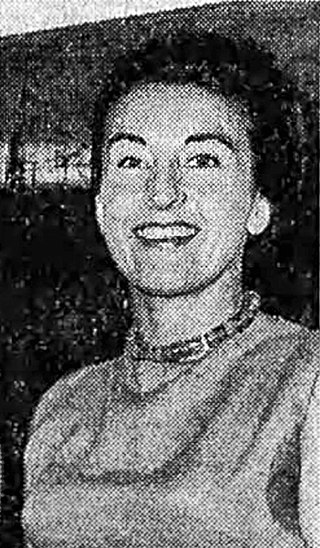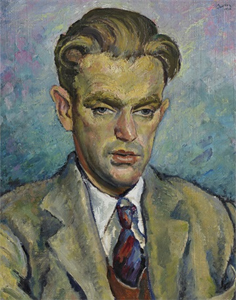Related Research Articles

George Frederick Henry Bell was an Australian painter and teacher, critic, portraitist, violinist and war artist who contributed significantly to the advancement of the local Modern movement from the 1920s to the 1930s.

Sir John Campbell Longstaff was an Australian painter, war artist and a five-time winner of the Archibald Prize for portraiture. His cousin Will Longstaff was also a painter and war artist.

The Athenaeum or Melbourne Athenaeum at 188 Collins Street is an art and cultural hub in the central business district of Melbourne, Victoria, Australia. Founded in 1839, it is the city's oldest cultural institution.

Victor George O'Connor was an Australian artist and an exponent of the principles of social realist art. From the time of the Great Depression in the 1930s his work embodied social and political comment on the conditions of working-class people and the structures of society that caused their suffering.

Alan McLeod McCulloch AO was one of Australia's foremost art critics for more than 60 years, an art historian and gallery director, cartoonist, and painter.

Constance Stokes was an Australian modernist painter who worked in Victoria. She trained at the National Gallery of Victoria Art School until 1929, winning a scholarship to continue her study at London's Royal Academy of Arts. Although Stokes painted few works in the 1930s, her paintings and drawings were exhibited from the 1940s onwards. She was one of only two women, and two Victorians, included in a major exhibition of twelve Australian artists that travelled to Canada, the United Kingdom and Italy in the early 1950s.

Lina Bryans, was an Australian modernist painter.
Peter Bray Gallery was established as Stanley Coe Gallery in 1949 before being renamed in 1951, after a change of management. Situated at 435 Bourke Street, Melbourne, Victoria, Australia, it closed in 1957. Many of the major names in mid-century Australian contemporary art showed there during its brief, but very busy, lifespan.

Polly Hurry, was an Australian painter. She was a founding member of the Australian Tonalist movement and part of the Twenty Melbourne Painters Society.
Ruth Sutherland (1884–1948), was an Australian painter and art critic. She was a founding member of the Twenty Melbourne Painters Society.
Dorothy Mary Braund (1926–2013) was an Australian post-war figuration and contemporary feminist artist, whose practice included painting, printmaking and teaching. Braund's extensive career was instrumental in contributing to the Modernist art scene, along with a generation of significant women artists including: Mary Macqueen, Barbara Brash, Anne Marie Graham, Constance Stokes, Anne Montgomery (artist) and Nancy Grant. Braund's first solo exhibition, held in 1952 at Peter Bray Gallery in Melbourne, launched her career and from then on she had consistent shows and exhibitions. Braund has had approximately 29 solo exhibitions and participated in 25 group exhibitions throughout her career. Braund is also a part of the Cruthers Collection of Women's Art.
William Frater (1890–1974) was a Scottish-born Australian stained-glass designer and modernist painter who challenged conservative tastes in Australian art.

Arnold Joseph Victor Shore was an Australian painter, teacher and critic.

Allan Holder Jordan (1898-1982) was an Australian painter, designer, printmaker and teacher.

Margaret Anne Dredge was an Australian painter and printmaker, active from the mid-1950s until 1997, and teacher of art.

Barbara Nancy Brash was a twentieth-century post-war Australian artist known for her painting and innovative printmaking. In an extensive career she contributed to the Melbourne Modernist art scene, beside other significant women artists including: Mary Macqueen, Dorothy Braund, Anne Marie Graham, Constance Stokes, Anne Montgomery (artist) and Nancy Grant.

Alan Robert Sumner, MBE was an Australian artist; a painter, printmaker, teacher and stained glass designer.

Jack Courier, a.k.a. John, was an Australian Modernist printmaker, painter and teacher.
Alexander Colquhoun was a Scottish-born Australian painter, illustrator and art critic.
The Australian Academy of Art was a conservative Australian government-authorised art organisation which operated for ten years between 1937 and 1946 and staged annual exhibitions. Its demise resulted from opposition by Modernist artists, especially those associated with the Contemporary Art Society, though the influence of the Academy continued into the 1960s.
References
- 1 2 Stephen, Clive; Scarlett, Ken; McClelland Gallery + Sculpture Park (2012). Clive Stephen: sculptor. Langwarrin, Vic.: McClelland Sculpture Pake + Gallery. ISBN 978-0-9804290-8-4. OCLC 816140154.
- 1 2 Eagle, Mary (1990). Australian modern painting: between the wars : 1914–1939. Sydney: Bay Books. ISBN 978-1-86256-427-5. OCLC 22987267.
- ↑ Printmaking, Prints and. "Clive Stephen". printsandprintmaking.gov.au. Retrieved 1 August 2022.
- ↑ Butler, Roger; Ballarat Fine Art Gallery (2003). Melbourne woodcuts and linocuts of the 1920's and 1930's. p. 49. ISBN 978-0-642-89501-1. OCLC 881470185.
- ↑ "Social". Table Talk. 28 July 1921. Retrieved 1 August 2022.
- ↑ Smith, Tim (16 September 2016). "Assessment Of Cultural Heritage Significance And Executive Director Recommendation To The Heritage Council : The Pines, 10 Middle Cres. Brighton". Heritage Victoria.
- ↑ "University Commencement". Leader. 11 April 1914. p. 38. Retrieved 1 August 2022.
- ↑ "University Of Melbourne". Argus. 4 January 1913. p. 18. Retrieved 1 August 2022.
- ↑ "University Of Melbourne. Medical Examinations". Argus. 6 January 1912. p. 16. Retrieved 1 August 2022.
- ↑ "University Of Melbourne". Argus. 17 April 1914. p. 12. Retrieved 1 August 2022.
- ↑ "Doctors For The Front". The Argus. 8 March 1915. p. 10. Retrieved 1 August 2022.
- ↑ "Personal". The Argus. 30 August 1915. p. 6. Retrieved 1 August 2022.
- ↑ "British Red Cross". Elmore Standard (Vic. : 1882 – 1920. 19 May 1917. p. 3. Retrieved 1 August 2022.
- ↑ "Red Cross Work". Elmore Standard (Vic. : 1882 – 1920. 19 May 1917. p. 3. Retrieved 1 August 2022.
- ↑ "Australian Military Forces". Commonwealth of Australia Gazette. 15 March 1917. p. 494. Retrieved 1 August 2022.
- ↑ "The Supreme Sacrifice". Elmore Standard (Vic. : 1882 – 1920. 11 May 1918. p. 3. Retrieved 1 August 2022.
- ↑ "Sad Fatality at Avonmore : The Inquiry". Elmore Standard. 5 January 1918. p. 3. Retrieved 1 August 2022.
- ↑ "Obituary". Elmore Standard (Vic. : 1882 – 1920. 1 June 1918. p. 3. Retrieved 1 August 2022.
- ↑ "They Say! The influenza scare..." Elmore Standard (Vic. : 1882 – 1920. 1 February 1919. Retrieved 1 August 2022.
- ↑ "Department of Public Health". Victoria Police Gazette. 10 May 1917. p. 267.
- ↑ "Family Notices". Argus. 12 October 1918. p. 11. Retrieved 1 August 2022.
- ↑ "Our Folks". Elmore Standard (Vic. : 1882 – 1920. 1 February 1919. p. 3. Retrieved 1 August 2022.
- ↑ National gallery of Victoria (Melbourne, Australie); Moore, Felicity St John (1992). Classical modernism: the George Bell circle. ISBN 978-0-7241-0155-9. OCLC 1264075973.
- ↑ Campbell, Ruth, "Madden, Sir John (1844–1918)", Australian Dictionary of Biography, Canberra: National Centre of Biography, Australian National University, retrieved 1 August 2022
- ↑ Hazzard, Margaret, "Rowan, Marian Ellis (1848–1922)", Australian Dictionary of Biography, Canberra: National Centre of Biography, Australian National University, retrieved 1 August 2022
- ↑ "Artists' Aliases : Everyone at the opening of the Group Twelve exhibition yesterday was interested in the provocative pictures but some were almost as interested in finding out the personalities hidden under the names of unfamiliar artists. M Barren Is Lady Barrett wife of the Chancellor of the University of Melbourne, Maie Casey is Mrs R G Casey wife of the Federal Treasurer, and Mary Alice Evatt is the wife of Mr. Justice Evatt of the High Court of Australia. Not all the exhibitors are in Melbourne. Mr. Roger James sent his exhibits from London and Miss K Sauerbier from Adelaide. Mr Pulleine, the son of a well-known South Australian doctor, the late Dr Pulleine is here, and Miss Marjorie North, Miss Bell and Dr Clive Stephen who varies medicine will sculpture in the modern manner, are well known in Melbourne. Dr Stephen is the nephew of the late Sir John Madden and Lady Madden and a relative by marriage of the late Mrs Ellis Rowan. Another absentee was Miss Moya Dyring who is in New South Wales painting in the hills near Sydney." "Heard Here and There". Argus. 17 June 1936. Retrieved 1 August 2022.
- 1 2 Young, Blamire (17 July 1933). "Modernists' School : Students' Exhibition". The Herald. p. 4. Retrieved 1 August 2022.
- 1 2 3 McCulloch, Alan; McCulloch, Susan; McCulloch Childs, Emily (2006). The new McCulloch's encyclopedia of Australian art. Fitzroy, Vic.; Carlton, Vic.: Aus Art Editions ; in association with the Miegunyah Press. ISBN 978-0-522-85317-9. OCLC 1135181250.
- ↑ "The Plastic Group". Age. 4 October 1935. p. 18. Retrieved 1 August 2022.
- 1 2 3 Plastic Group, [Plastic Group : Australian Gallery File] , retrieved 1 August 2022
- 1 2 "Heard Here and There". Argus. 17 June 1936. p. 12. Retrieved 1 August 2022.
- ↑ Nibbi, Gino (August 1939). "Ideas Behind Contemporary Art". Art in Australia: A Quarterly Magazine (76): 18.
- ↑ "Head of a woman (1933) Ian Fairweather". National Gallery of Victoria. Retrieved 1 August 2022.
- ↑ Roberts, Claire (2021). Fairweather and China. ISBN 978-0-522-87716-8. OCLC 1317822294.
- ↑ Fairweather, Ian; Roberts, Claire; Thompson, John (2019). Ian Fairweather: a life in letters. ISBN 978-1-925355-25-3. OCLC 1108158022.
- ↑ "Clive Stephen". National Gallery of Australia. Retrieved 1 August 2022.
- ↑ "Clive Stephen, NGV". National Gallery of Victoria. Retrieved 1 August 2022.
- ↑ "Works by Clive Stephen | Art Gallery of NSW". www.artgallery.nsw.gov.au. Retrieved 1 August 2022.
- ↑ "STEPHEN, Clive | QAGOMA Collection Online". collection.qagoma.qld.gov.au. Retrieved 1 August 2022.
- ↑ "Clive Travers STEPHEN". Art Gallery WA Collection Online. Retrieved 1 August 2022.
- ↑ "Melbourne Chatter". The Bulletin. 57 (2941): 43. 24 June 1936.
- ↑ The Parliament of the Commonwealth of Australia : Australia Council (1976–1977). Blainey, Geoffrey (ed.). "Parliamentary Paper No. 52/1978 : Australia Council Annual Report 1 July 1976 – 30 June 1977". Trove. Retrieved 1 August 2022.